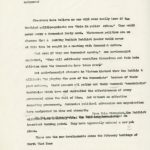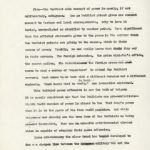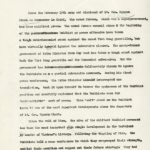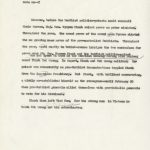1964, March 4, “Madame Ngo Dinh Nhu”

deepe
madame–1
march 4, 1965
SAIGON–Yes, Madame Ngo Dinh Nhu was probably right about the Buddhists.
But no one will ever know for sure.
When the lovely spitfire sister-in-law of the former President Ngo Dinh Diem labelled the militant Buddhist monks as “Reds in yellow robes,” she also caused an internal and international fuf furor.
And her attacks indirectly aided the monks–who were later to spark the overthrow of the Ngo regime 1516 montshhs ago–by creating for them an alrea dy already unpopularbecoming a target they needed symbolically to attack. Her vitrolic remarks also effected to sabotage the[Resulted in sparking?] attempts to comprim compromise between the Buddhist militants and her brother-in-law the President.
(More)
deepe
madame–2
Observers here believe no one will ever really know if the Buddhist politico-priests are “Reds in yellow robes.” They would never carry a Communist Party card. Vietnamese politics are so obscure that a ranking Buddhit Buddhist leader would never at this time be caught in a meeting with Communist cadres.
“And even if they are Communist agents,” one ex-Communist explained, “they will selflessly sacrifice themselves and fade into oblivion once the Communists have taken over.”
But anti-Communist elements in Vietnam instead view the Buddhis t militants “as playing the game of the Communists” because of their past actions, their present p9l policy and their “anarach “anarchistic” tendencies which have shf shrivelled the effectiveness of every government since the fall of Diem. And without an effective competing government, Communist political subversion and organization have mushrommed in size and strength. From this viewpoint,the Buddhist militants have obviously sided the Viet Cong cadre.
In the past three years, the Buddhists have established an important turning point. They have apparently entered a new pah phase.
These are the new developments since the February bombings of North Viet Nam:
deepe
madame–3
march 4, 1965
one–Except for the Viet Cong Communists, the militant Buddhists organization is the most important power grouping in the Vietnam. Their potential power now appears to overh overshadow that of both the milixx country’s government and armed forces, which is has become since the February 19th coup attempt more divided and less politically sensex oriented. Neither the armed forces nor the government appears prepared to resist the growing stre strength of the Buddhist militants.
two– During the Diem regime, the militant Buddhists were x a clandestine, underground semi-underground political dissident movement, which used religious persecution as their battlecry. SinceAfter the fall of Diem, however, they have becomebecame a political movement of protest, which successfully neutralized or spearheaded the toppling of each of the successive governments. Now, as of mid-February, they have become part of the government of Prime Minister Phan Huy Quat–and have a aquiredacquired a sizeable chunk of that government.
three–at least momentarily, the Buddhists appear to have ended their period of protests against the government–since they have become part of that government. However, they h now have manufactureddeveloped a new issue–peace. Their appeal current appeals for peace may in the future become protests for peace, which willwould again serve to increase the Buddhist power over the masses.
deepe
madame–4
four–forDuring the past 1516 months sincefollowing the fall of Diem, the Buddhists havehad been a third government–operating between the Saigon government and the Viet Cong guerrillas tppn political backbone of the Viet Cong guerrillas, the National Liberation Front for South Viet Nam. In a nan importa nt position paper, a leading monk said the militant Buddhist movement was against both the Communists and the anti-Communst Communists, which he described as the Catholics and the Americans. It was clear from their policy that their immediate enemy was the Sa igon government–and not the Viet Cong.
Now, however, that they have beome become part of them a substantia l part of the Saigon government, it would appear to be the timetimely for them to declare war on the Communists.
But, they have not. Instead in mid-February they launched their peace offensive, wyich which places them in the position of rising [As An Arbiter?] above both the other states–the Saigon government and the Viet Cong.
It is reliably predicted that in the coming months, the Buddhists will move into the position of being the link–or “the hyphen” between between the Saigon government and the Viet Cong, thus paving the way for the coalition government which the Viet Cong have always wanted a part of their neutralization of the country.
(More)
deepe
mada me–5
five–The Buddhist cone concept of peace is openly, if not deliberately, ambiguous. One pr Buddhist priest gives one concent concept to Western and local correspondents, only to have it denied, contradicted or clarified by another priest. More significant than the official statements given to the press is the sermons which the Buddhist priests are giving to the masses, which is their source of power. Frankly, no one really knows what their they say in their sermons. The foreign embassies, the prime minister’s office, the secret police, the Catholics are and the foreign press [?] are each known to send a number of “reporters” to attend the Buddhist sermons. Each comes ba ck back with a different version and a different emphasis. “Each hears what he wantsto hear,” one journalist explained.
This Buddhist peace offensive is now the talk of Saigon. It is openly considered now that the Buddhists are pro-neutralists–thatth their versions of peace is closer to the Viet Cong’s peace than it is to the peace of the free world position. And while Saigonese now clearly see the true face of the Buddhists as being pre-ent neutralist, they see no cohesive anti-Communist element which is capable of stopping their peace offensive.
Since mid-February the clear trend has been d developed to dra w a sharper line between the Saigonesm military war and the political subversive war.
deepe
madame–6
Since the February 19th coup and dismissal of Lt. Gen. Nguyen Khanh as Commander in Chief, the armed forces, which washad been a supergovernment, has nowless political power. The armed forces council since T the beginning of the peace offensive Buddhist pa peace offensive have taken a tough anti-Communist stand against the armed Viet Cong guerrillas, but have virtually ignor3d ignored the subversive element. The newly-formed government of Prime Minister Phan Huy Quat has taken a tough stand against both the Viet Cong guerrilla and the Communist subversive. But the government has takenmxafirsmmonltmxmimmed deliberately chosen to ignore the Buddhists as a a partial subversive movement. During his first press conference, the Prime Minister himself interrupted one translation, took it upon himself to become the spokesman of the Buddhist position and carefully explained that the Buddhists were for “nationalistic” sort of peace. This “soft” stand on the Buddhist issue is one of the most important developments since the departure of Lt. Gen. Nguyen Khanh.
Since the fall of Diem, the rise of the militant Buddhist movement has been the most important sign single development in the turbulent 1516 months of Vietnam’s history. [In ?] Following the toppling of Diem, the Buddhists held a mass conference in which they re-grouped their strength, unified their position and mapped out their future strategy. They had already launched a whispering campaign agains t the first Prime Minister of the Nguyen Ngoc Tho of the first mmlitar military junta.
deepe
madame–7
However, before the Buddhist politico-priests could marshall their forces, Maj. Gen. Nguyen Khanh seized power as prime minister. Throughout the year, the armed power of the armed pass forces skirted the ma growing mass power of the pro-neutralist Buddhists. Throughout the year, restl mostly in behind-scenes intrigue the two contenders for power were Lt. Gen. Nguyen Khanh and the Buddhist politico-priest named Thich Tri Quang who had spent 64 days in the American Embassy during Diem regime. In August Khanh and Tri Quang collided; the priest won momentarily as pro-Buddhist demonstrations toppled Khanh from the Pre siden Presidency. But Khanh, with brilliant maneuvering, q uickly re-established himself as the strongman–until February 20 when pro-Buddhist generals allied themselves with pro-Catholic generals to vote for his dismissal.
Khanh then left Viet Nam. Now the strong man in Vietnam is Thich Tri Quang andbacked by his subordinates.






